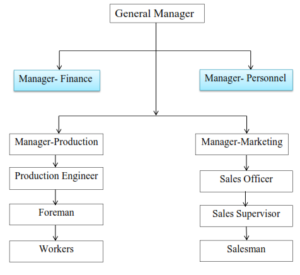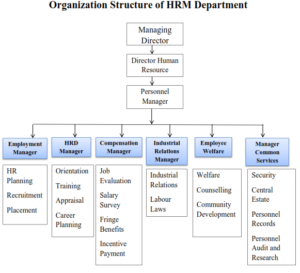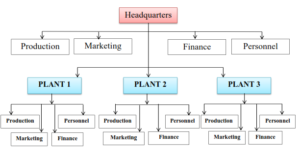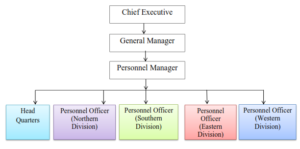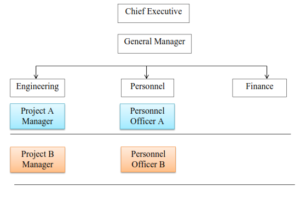Structure of Personnel Department
The organization structure is based on the way various activities are grouped together to create departments and units and prescribing their relationships in the organization. The internal structure of a personal department depends on various factors such as nature and size of the organization, managerial preference to structure operations clearly, external forces etc. Small firms have only a single section headed by a personnel officer taking care of everything. Medium sized firms may create a separate personnel department having experts in the personnel field supported by administrative staff. In large organizations the structure of a personnel department may take various shapes, depending on organizational resources, competitive pressures and total employee strength.
Personnel department in Line Organization
In line Organizations:
- Line of authority and instructions are vertical i.e. top to bottom.
- Every superior has direct command over his immediate subordinate.
- Every employee is accountable to one superior i.e. there is unity of command. All persons at same level are independent of each other. It implies that all dept. heads are supreme in their respective areas and independent of one another and are responsible to chief executive.
- The authority relationships are clear and there is strict discipline.
- There is lack of specialization and flexibility. It forces Line managers to perform additional duties requiring special knowledge for which they may not be fitted. He has to depend on his own abilities and resources.
- Autocratic approach
- Problems of Co-ordination
- Not suitable for large organization.
Personnel Department in Functional Organization
In functional Organizations :
- All activities in the company are grouped according to certain functions like production, marketing, finance and personnel.
- Each functional area is headed by a specialist who directs the activities o that area for the entire organization.
- Line of authority is diagonal.
- The functional head has line authority over subordinates in his own functional area.
- There is high degree of control and coordination of functions because all work of one kind is under one manager.
- Functional structure essentially generates slow decision making process because the problem requiring a decision has to go through various departments as all of them have something to say on the matter. Functional structure offers usually line and staff conflict and interdepartmental conflict. They tend to find over power, resources and benefits.
Personnel Department in Divisional Organization
In Divisional Organizations :
- In divisional organsiation structure, personnel staff are attached to divisional heads.
- Divisional structure, also called profit decentralization by Newman and others, is built around business units. In this form the origination is divided into several fairly autonomous units. Each unit is relatively self –contained in that it has the resources to operate independently of other divisions. For example, each division has its own manufacturing, engineering, marketing etc.
- There are different bases on which various divisions in an organization an be created.
- The personnel officer at divisional level is responsible to the local divisional manager. He subordinate to the personnel manager at the head office.
- The main advantage of divisionalisation is that the HR issues of employees can be sorted out expediously in the division itself.
- Divisional structure is quite costly because all the facilities have to be arranged for each division.
- Often there is lack of managerial personnel when a new division is opened because managers working within a division cannot work with same efficiency in other division as they must have acquired the technical competence of that division.
Personnel Department in Matrix Organization
In Matrix Organisations:
- Matrix organization is essentially a violation of unity of command.In a matrix organization structure, every employee has two superiors.
- Two complementary structures – pure project structure and functional structure are merged together to create matrix structure. One chain of command is functional head and the other is the project head. A personnel officer, is accountable to the personnel manager (vertical dimension) and to the project manager (horizontal dimension).
- In large organizations employees from various functional departments are from time to time assigned to one or more projects. On completion of the project these employees revert back to their respective departments until the next assignment to a project.
- The problem with this kind of structure is that there is always power struggle among people which may become dysfunctional if top management does not play active role in balancing the power.
- There is delay in decision making as many persons are involved in the decision process. Each person hold veto power or may not give consent because of power struggle and conflict.
Personnel Department in Line and Staff Organization
In Line and Staff Organsiations :
- Line and staff organization structure refers to a pattern in which staff specialists advise managers to perform their duties.
- The staff positions or departments are of purely advisory nature.
- The line and staff structure is based upon the principle of specialization. The line managers are responsible for operations contributing directly to the achievement of organizational objectives whereas staff people are there to provide expert advice on the matters of their concerns.
- Line and staff organization is more suitable to large enterprises.
- The main problem of line and staff structure is the conflicts between line and staff managers. Such conflicts may be because of various reasons and sometimes the organizational conflicts may be taken as personal conflicts resulting in interpersonal problems.

